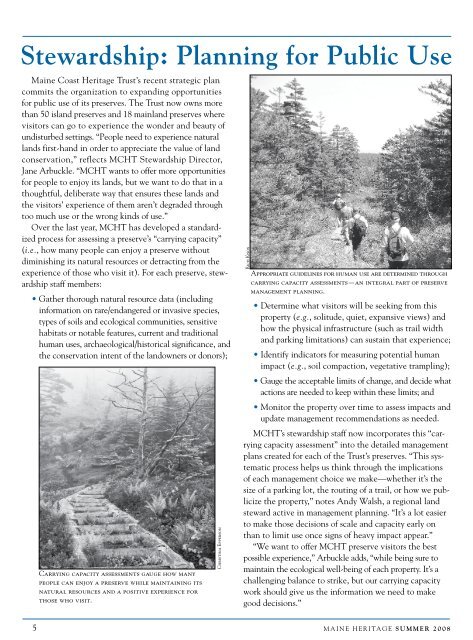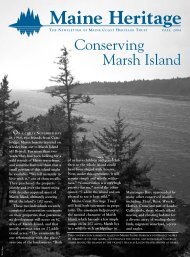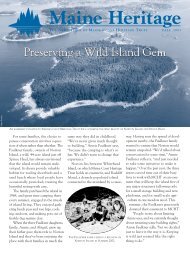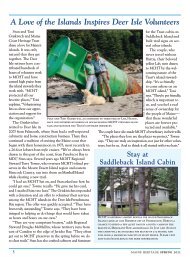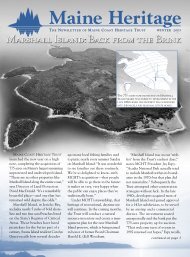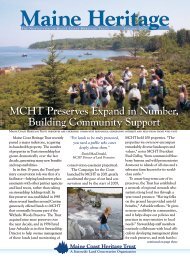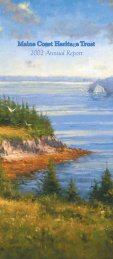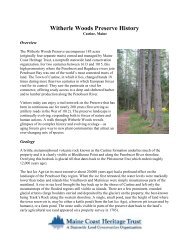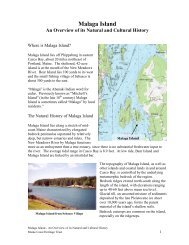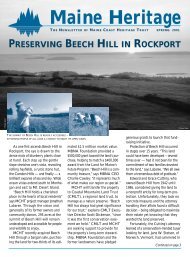Stewardship Planning for Public Use
Download a PDF file of this newsletter for printing. - Maine Coast ...
Download a PDF file of this newsletter for printing. - Maine Coast ...
You also want an ePaper? Increase the reach of your titles
YUMPU automatically turns print PDFs into web optimized ePapers that Google loves.
<strong>Stewardship</strong>: <strong>Planning</strong> <strong>for</strong> <strong>Public</strong> <strong>Use</strong>Maine Coast Heritage Trust’s recent strategic plancommits the organization to expanding opportunities<strong>for</strong> public use of its preserves. The Trust now owns morethan 50 island preserves and 18 mainland preserves wherevisitors can go to experience the wonder and beauty ofundisturbed settings. “People need to experience naturallands first-hand in order to appreciate the value of landconservation,” reflects MCHT <strong>Stewardship</strong> Director,Jane Arbuckle. “MCHT wants to offer more opportunities<strong>for</strong> people to enjoy its lands, but we want to do that in athoughtful, deliberate way that ensures these lands andthe visitors’ experience of them aren’t degraded throughtoo much use or the wrong kinds of use.”Over the last year, MCHT has developed a standardizedprocess <strong>for</strong> assessing a preserve’s “carrying capacity”(i.e., how many people can enjoy a preserve withoutdiminishing its natural resources or detracting from theexperience of those who visit it). For each preserve, stewardshipstaff members:• Gather thorough natural resource data (includingin<strong>for</strong>mation on rare/endangered or invasive species,types of soils and ecological communities, sensitivehabitats or notable features, current and traditionalhuman uses, archaeological/historical significance, andthe conservation intent of the landowners or donors);Carrying capacity assessments gauge how manypeople can enjoy a preserve while maintaining itsnatural resources and a positive experience <strong>for</strong>those who visit.Christina EppersonRich KnoxAppropriate guidelines <strong>for</strong> human use are determined throughcarrying capacity assessments—an integral part of preservemanagement planning.• Determine what visitors will be seeking from thisproperty (e.g., solitude, quiet, expansive views) andhow the physical infrastructure (such as trail widthand parking limitations) can sustain that experience;• Identify indicators <strong>for</strong> measuring potential humanimpact (e.g., soil compaction, vegetative trampling);• Gauge the acceptable limits of change, and decide whatactions are needed to keep within these limits; and• Monitor the property over time to assess impacts andupdate management recommendations as needed.MCHT’s stewardship staff now incorporates this “carryingcapacity assessment” into the detailed managementplans created <strong>for</strong> each of the Trust’s preserves. “This systematicprocess helps us think through the implicationsof each management choice we make—whether it’s thesize of a parking lot, the routing of a trail, or how we publicizethe property,” notes Andy Walsh, a regional landsteward active in management planning. “It’s a lot easierto make those decisions of scale and capacity early onthan to limit use once signs of heavy impact appear.”“We want to offer MCHT preserve visitors the bestpossible experience,” Arbuckle adds, “while being sure tomaintain the ecological well-being of each property. It’s achallenging balance to strike, but our carrying capacitywork should give us the in<strong>for</strong>mation we need to makegood decisions.”5 Maine Heritage Summer 2008
Maine HeritageT h e Ne w s l e t t e r o f Ma i n e Co a s t He r i ta g e Tr u s t S u m m e r 2008Preserving a Storied Casco Bay IslandRic h Kn o xThe longtime owners of Ragged Island, an important seabird nesting site and community landmark in Eastern Casco Bay,are working with Maine Coast Heritage Trust to permanently protect the 77-acre island’s scenic and ecological values.Lying at the seaward edge ofEastern Casco Bay, Ragged Island isa 77-acre landmark rich in historyand ecology. Much of this offshoreisland provides valuable nesting habitat<strong>for</strong> eider ducks (325 pairs at lastcount) and guillemots, while a traditionalfarmstead area adds ecologicaldiversity and cultural interest—withovergrown orchards, pastures whereoats, hops and timothy have gonewild, and a lobster pound painstakinglyhand-crafted from stone.For decades during the 19thcentury, people lived year-roundon Ragged. One of the betterknownresidents, Reverend ElijahKellogg, served Harpswell as aCongregationalist minister <strong>for</strong>long stretches between 1843 and1901—happily situated equidistantby boat from his parishioners onBailey and Orrs Islands and those inRich KnoxCundy’s Harbor. Kellogg was one ofMaine’s most prolific writers, completing30 books <strong>for</strong> boys—includingan Elm Island series of adventures seton Ragged Island.Abandoned <strong>for</strong> a time in the early20th century, Ragged Island becamea favorite spot of rumrunners duringRagged Island has a fascinating history ofhuman use going back nearly two centuries.Prohibition. In 1933, poet Edna St.Vincent Millay bought the island andsummered there with her husbanduntil her death in 1950.Paul and Claire Sifton purchasedRagged Island the following year, andtheir three grandsons—Sam, John andToby Sifton—now share ownership.Late this summer, they will transfera conservation easement to MaineCoast Heritage Trust that preventsfuture subdivision and limits futureconstruction—clustering it nearthe existing house. The easementprovides <strong>for</strong> continued public useof a traditional picnicking beach atthe island’s northern end. “Raggedhas always belonged to the peopleof Harpswell as much as to us,”John Sifton says, noting how arearesidents use it both <strong>for</strong> fair weatherenjoyment and foul weather emergencies.“We’re preserving it <strong>for</strong> themcontinued on page 2
From MCHT’s Board ChairOver the last sixmonths I have hadthe opportunityTom Ireland to be more deeplyinvolved in MCHT’s work than everbe<strong>for</strong>e. It has proven to be an exhilaratingexperience, watching the Trust’sstaff and board members advanceongoing programs; organize an inspiringand in<strong>for</strong>mative conference <strong>for</strong>400 conservationists; launch severalnew initiatives (like the MaineLand Trust Excellence Program,The Norumbega Society and “carryingcapacity” assessments, all highlightedin this issue); and complete a successfulsearch <strong>for</strong> a new president.Our capable and hard-workingSearch Committee, under the veryable leadership of Chair Linzee Weld,found a new president <strong>for</strong> MCHTwith the skill, passion and energyMCHT’s incoming president Paul Gallay.to sustain this fabulous momentum.We are delighted to welcome aboardPaul Gallay, who comes to us fromWestchester Land Trust in New YorkState where he served <strong>for</strong> eight yearsas executive director—achievinga seven-fold increase in conservedlands and creating five local conservationchapters. He had workedpreviously in the New York AttorneyGeneral’s Office on wetlands issuesand as Special Assistant to theCommissioner of the New YorkState Department of EnvironmentalConservation. Paul will be using thiscolumn—in future issues—to expresshis ideas and initial impressions.It has been my great pleasureover the past six months to sharethe helm with David MacDonald,MCHT’s experienced and insightfulInterim President, and to get betteracquainted with so many of theTrust’s energetic and dedicated staff,board and supporters. I want toextend particular thanks to Davidfrom the entire Board <strong>for</strong> his especiallycommitted service duringthis interim period. I look <strong>for</strong>wardto continued work with all of youduring this exciting and energizingtime at the Trust.Preserving a Storied Casco Bay Islandcontinued from page 1as much as <strong>for</strong> us.”“Our mother has always wantedthe island to be protected,” Siftonadds, “and none of us cared to seea building or lifestyle here thatwouldn’t serve the wildlife well.”That desire lay dormant <strong>for</strong> yearsuntil—in just three years—theisland’s property taxes rose 250 percent,motivating family members totake action. The Siftons sought tokeep Ragged Island in their familyand give the fourth generation ofSiftons a chance to experiencethe place as their great grandparentshad. By selling an easementto MCHT (even at a very generous“bargain sale” rate 40 percent belowappraised value), they could generatefunds to cover future taxes and upkeepwhile ensuring that—in John Sifton’swords—“the island will stay the way itis <strong>for</strong>ever.”Thanks to Ragged Island’s highconservation values, MCHT has beenable to secure a diverse array of grantsto help fund the easment acquisition.The U.S. Fish & Wildlife Service,which has long viewed Ragged as atop priority <strong>for</strong> permanent habitatprotection, awarded funds toward theproject, along with the Casco BayEstuary Partnership, the Julie N.Oil Spill Settlement Fund, and DucksUnlimited. “To complete the purchase,”notes Project Manager BetsyHam, “we still need $75,000 in privatecontributions. We hope that thosewho know and love Ragged Islandwill step <strong>for</strong>ward to help us secure thefuture of this exceptional place.”Rich KnoxThere, there where thoseblack spruces crowdTo the edge of theprecipitous cliff,...There, thought unbraids itself,and the mind becomes single.Edna St. Vincent Millay“Ragged Island”2 Maine Heritage Summer 2008
First Espy Land Heritage Award HonorsDavid Getchell, Sr.Eliza Ginn, MITAAt the 2008 Maine LandConservation Conference, MCHTannounced that it had renamed theLand Heritage Award in honor of<strong>for</strong>mer Trust President Jay Espy andthat several generous donors hadpersonally endowed it to providea $5,000 cash gift that could go toany land conservation organizationof the recipient’s choosing.The Trust then presented the firstEspy Land Heritage Award to DavidGetchell, Sr., a pioneering conservationistwho founded both theMaine Island Trail Association(MITA) and the ConservationTrails Program at Georges RiverLand Trust (GRLT), and was theinspiration behind the GeorgesHighland Path (an ambitious36-mile footpath involving nearly40 different private landowners).Former Trust President Jay Espy helpedhonor Dave Getchell at the conference.He also co-founded the NorthAmerican Water Trails Associationand served <strong>for</strong> 12 years on theMaine Trails Advisory Committee.Getchell has chosen to share theGRLTDave Getchell, Sr., who received MCHT’sfirst Espy Land Heritage Award, has ledmany successful trail-building initiativesin Maine and beyond.cash award with MITA, GRLT andFriends of Baxter State Park (wherehe serves as an Honorary Director).In receiving the award, DaveGetchell emphasized the importanceof good relationships with landownersand a well-educated publicin creating conservation success.“In these somewhat cynical times,”he observed, “it’s heartening to seeso many private landowners willingto share their land with a caringpublic. In my experience, the vastmajority of hikers and boaters donot need strict rules or policing.They respond with respect andappreciation, feeling privileged toenjoy these beautiful places.”Getchell has shared his prodigiousknowledge of trail construction andmanagement, boating and otheroutdoor skills through service onnumerous committees and throughin<strong>for</strong>mal counsel to others. “DaveGRLTis one of those rare individualswho—through his unique gifts andtalents—has greatly advanced thecause of conservation in Maineand has left indelible impressions,not just on the land he loves, butalso on the people who work withhim,” reflects Rachel Nixon whoworked closely with Getchell in her<strong>for</strong>mer role as GRLT’s ExecutiveDirector. “He has inspired people,brought them together, extendedtheir collective vision, and set highstandards that others then follow.Working with Dave improves thequality of one’s own work.”Numerous conservation groups in Mainehave been beneficiaries of Dave Getchell’ssteadfast trail-building ef<strong>for</strong>ts.3 Maine Heritage Summer 2008


